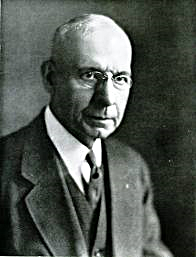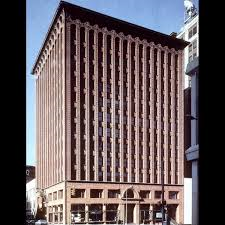Form Follows Function: Louis Sullivan and the Skyscraper
 Monday, August 18, 2014 at 1:46PM
Monday, August 18, 2014 at 1:46PM  Louis Sullivan Week Three of our August stroll through some iconic American styles of building with legendary architects. Today we get on a new fangled elevator with Chicago School architect Louis Sullivan, called the Father of the Skyscraper and the Father of Modern Architecture.
Louis Sullivan Week Three of our August stroll through some iconic American styles of building with legendary architects. Today we get on a new fangled elevator with Chicago School architect Louis Sullivan, called the Father of the Skyscraper and the Father of Modern Architecture.
In last week’s column we boldly asserted that Thomas Jefferson was the only US president who could read architectural blueprints. (He also drew them.) Later in the week I remembered that Jimmy Carter probably has that skill also; since 1984 he has vigorously championed Habitat for Humanity and its construction of homes for low income folks around the world. Jimmy and Rosalynn have literally hammered and sawed many, many homes. Sorry, Jimmy.
Today I bring you the only US architect who was also a poet. I’ll probably have to issue a correction of addition on that one too. It has surprised and delighted me, in doing this series, to discover these architects with other interesting abilities – to write poetry, or lead a nation.
Louis Sullivan (1856-1924) wrote his best-known poem in 1896. He was already a successful and acclaimed Chicago architect who, with others, had designed the very first skyscraper. Using a new kind of steel from down the road in Pittsburgh, Sullivan crafted the landmark Wainwright building in Chicago and the Guaranty building in Buffalo, which didn’t have to depend on load-bearing masonry walls. These steel framed structures with “curtain walls” were the first to rise above the then limit of 6-8 floors.
 Wainwright Building, Chicago
Wainwright Building, Chicago Guaranty Building, BufaloIt was a dramatic, cusp kind of time in the Midwest. After the 1870 Chicago Fire destroyed thousands of buildings, city leaders vowed to rebuild from the ashes a modern city to meet the boom of railroad, grain and cattle markets. The lure of full employment brought streams of immigrants to the city, doubling Chicago’s populations in the decade after the fire. Niagara Falls brought cheap electricity, revealed to the world in the sparkle of the “White City” of the 1893 Exposition. Mr. Otis invented an elevator safe not just for grain but people. In Chicago and New York was born the idea of a concentrated financial “downtown,” a uniquely American word and invention.
Guaranty Building, BufaloIt was a dramatic, cusp kind of time in the Midwest. After the 1870 Chicago Fire destroyed thousands of buildings, city leaders vowed to rebuild from the ashes a modern city to meet the boom of railroad, grain and cattle markets. The lure of full employment brought streams of immigrants to the city, doubling Chicago’s populations in the decade after the fire. Niagara Falls brought cheap electricity, revealed to the world in the sparkle of the “White City” of the 1893 Exposition. Mr. Otis invented an elevator safe not just for grain but people. In Chicago and New York was born the idea of a concentrated financial “downtown,” a uniquely American word and invention.
So together coalesced steel, labor, space, power and many creative individuals to create one more necessity for this radical leap; developers with a financial incentive to build up and up. How much money could one make per square foot of increasingly valuable property? Sullivan’s response: the skyscraper.
Sullivan’s clients wanted their buildings to make as much money as possible; that was the building’s function. But Sullivan was still an artist, as architects are, not just engineers. He had already written that a tall building “must be every inch a proud and soaring thing, rising in sheer exultation that from bottom to top it is a unit without a single dissenting line.”
But his poem coined the phrase that forever identifies Sullivan with modern architecture:
It is the pervading law of all things organic and inorganic,
Of all things physical and metaphysical,
Of all things human, and all things super-human,
Of all things true manifestations of the head,
Of the heart, of the soul.
That life is recognizable in its expression,
That form ever follows function. This is the law.
Form follows function. Until then, architectural form was required to follow precedent. Palladian or Colonial or Georgian, or whatever; there was the accepted, expected form for every building. Its function had to adapt to that form. Behind the portico with columns or the two symmetrical wings, the actual rooms, the kitchen, bedrooms, offices just had to fit in.
Sullivan is said to have objected to the way “form follows function” became a hard and dry echo of modernism. He continued to use decoration, ornamentation and aesthetics in all his buildings. Art Deco cornices and neo-Romanesque arches that had been popular pre-skyscraper he featured in his buildings. He preferred to credit his poetic insight to first-century Roman architect Vetruvius, who said all buildings must have three things: utilities, firmitas and venustas, that is, usefulness, strength and beauty; he was just emphasizing one of them.
But his simple phrase, “form follows function” seized the imagination of a new century and laid the foundation (good architectural figure of speech!) for the 20th century International Style we see in Le Corbusier, Phillip Johnson and others; huge buildings of rectilinear planes, seemingly weightless, free of ornamentation.
Sullivan himself kept designing for decades after this early triumphs, though he had some personal and economic ups and downs. He ended his career specializing in small town bank buildings father west, that some say are his best work. His most famous student was Frank Lloyd Wright, whose work became known as the Prairie Style.
It all feels so very American; the Midwest, the city bustle of railroads and markets, commerce and downtowns. The small towns and prairies. A preoccupation with function, what is it FOR? The creative genius who has a hard life of boom and bust. And skyscrapers, buildings, in Sullivan’s words, that are proud and soaring, rising in sheer exultation.
___________________
Next Week: Julia Morgan and West Coast “building with nature.”
Copyright © 2014 Deborah Streeter
Reader Comments